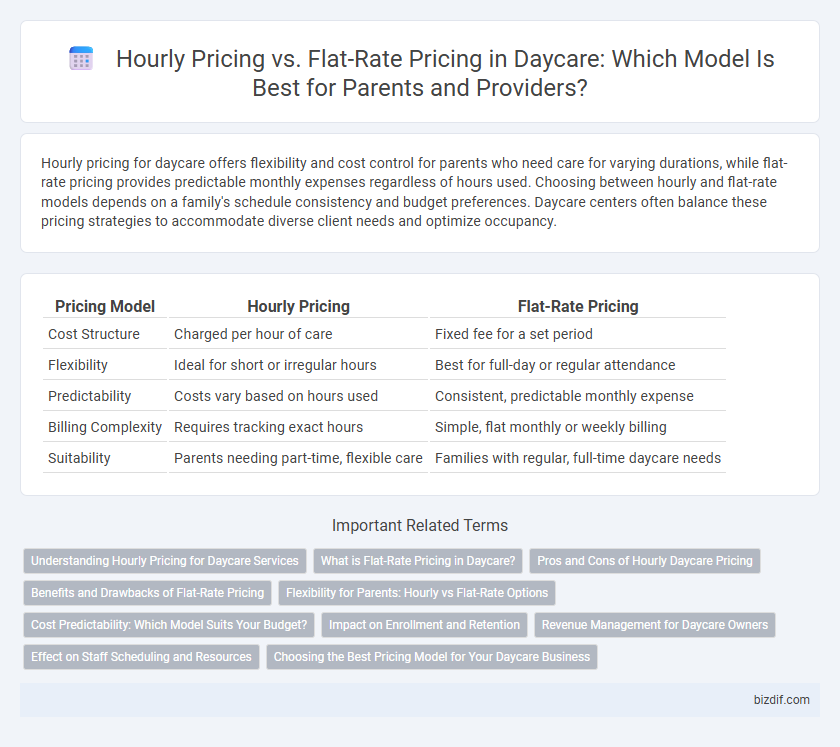Hourly pricing for daycare offers flexibility and cost control for parents who need care for varying durations, while flat-rate pricing provides predictable monthly expenses regardless of hours used. Choosing between hourly and flat-rate models depends on a family's schedule consistency and budget preferences. Daycare centers often balance these pricing strategies to accommodate diverse client needs and optimize occupancy.
Table of Comparison
| Pricing Model | Hourly Pricing | Flat-Rate Pricing |
|---|---|---|
| Cost Structure | Charged per hour of care | Fixed fee for a set period |
| Flexibility | Ideal for short or irregular hours | Best for full-day or regular attendance |
| Predictability | Costs vary based on hours used | Consistent, predictable monthly expense |
| Billing Complexity | Requires tracking exact hours | Simple, flat monthly or weekly billing |
| Suitability | Parents needing part-time, flexible care | Families with regular, full-time daycare needs |
Understanding Hourly Pricing for Daycare Services
Hourly pricing for daycare services offers flexibility, charging parents only for the exact time their child spends in care, which can be cost-effective for irregular schedules. This model allows families to pay based on actual usage, avoiding the higher costs associated with flat-rate fees that cover fixed blocks of time regardless of attendance. Understanding hourly pricing is essential for parents seeking affordable, tailored childcare solutions that adapt to dynamic daily routines.
What is Flat-Rate Pricing in Daycare?
Flat-rate pricing in daycare refers to a fixed fee charged for childcare services regardless of the number of hours used, providing predictable monthly or weekly costs for parents. This pricing model simplifies budgeting and typically covers a set schedule or unlimited hours within operational times. Many daycares offer flat-rate plans for full-time enrollment, promoting stability and consistent revenue streams for the facility.
Pros and Cons of Hourly Daycare Pricing
Hourly daycare pricing offers flexibility for parents needing childcare only for short periods, allowing cost-efficiency when care is infrequent. However, this model can lead to unpredictability in monthly expenses and may result in higher overall costs compared to flat-rate pricing if hours accumulate. Providers benefit from maximizing revenue during peak times but face challenges in scheduling and billing complexity.
Benefits and Drawbacks of Flat-Rate Pricing
Flat-rate pricing in daycare provides predictable monthly costs, simplifying budgeting for families and ensuring steady revenue for providers. However, it may lead to overpayment when children attend less frequently, potentially causing dissatisfaction among parents who prefer paying strictly for hours used. This pricing model benefits providers by reducing administrative complexity but might deter flexible attendance patterns.
Flexibility for Parents: Hourly vs Flat-Rate Options
Hourly pricing offers parents significant flexibility by allowing them to pay only for the exact time their child spends at daycare, making it ideal for irregular schedules or part-time care. Flat-rate pricing provides predictability and convenience with a fixed monthly or weekly fee, beneficial for parents with consistent routines and full-time childcare needs. Choosing between hourly and flat-rate options depends on balancing flexibility with budgeting preferences to best accommodate diverse family schedules.
Cost Predictability: Which Model Suits Your Budget?
Hourly daycare pricing offers flexibility but can lead to fluctuating monthly expenses, making budget planning challenging for families with irregular schedules. Flat-rate pricing provides consistent, predictable costs, ideal for parents seeking financial stability and easier expense management. Understanding these pricing models helps parents choose the best fit for their financial routine and childcare needs.
Impact on Enrollment and Retention
Hourly pricing in daycare offers flexibility, appealing to parents with variable schedules, which can boost short-term enrollment but may lead to unpredictable revenue streams. Flat-rate pricing provides financial predictability and can enhance retention by encouraging consistent attendance, fostering trust and long-term commitment from families. Understanding the balance between flexible hourly rates and stable flat fees is crucial for optimizing both enrollment figures and retention rates in daycare centers.
Revenue Management for Daycare Owners
Daycare owners optimize revenue management by carefully analyzing hourly pricing versus flat-rate pricing models. Hourly pricing offers flexibility and can maximize income during peak demand periods, while flat-rate pricing ensures predictable, consistent cash flow. Strategic implementation of these pricing structures, aligned with attendance patterns and market competition, drives profitability and sustainable growth in daycare operations.
Effect on Staff Scheduling and Resources
Hourly pricing in daycare allows for flexible staff scheduling, aligning workforce hours directly with fluctuating attendance and ensuring optimal resource allocation. Flat-rate pricing often requires consistent staffing levels regardless of daily attendance variability, potentially leading to overstaffing or understaffing issues. Efficient staff scheduling under hourly models can reduce labor costs and improve resource utilization by matching employee availability to actual childcare demand.
Choosing the Best Pricing Model for Your Daycare Business
Choosing the best pricing model for your daycare business involves evaluating your target market and operational costs. Hourly pricing offers flexibility for parents with variable schedules, while flat-rate pricing ensures predictable revenue and simplifies billing. Analyzing enrollment patterns and competitor pricing helps optimize profitability and client satisfaction.
Hourly pricing vs flat-rate pricing Infographic

 bizdif.com
bizdif.com